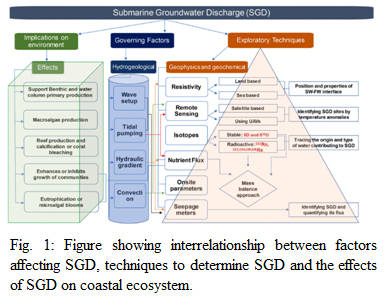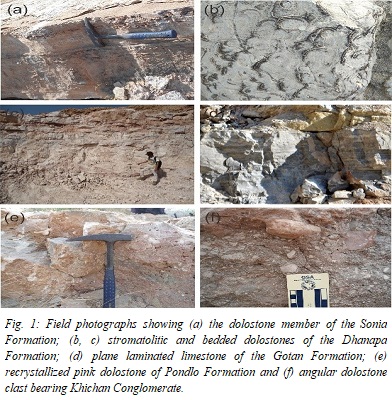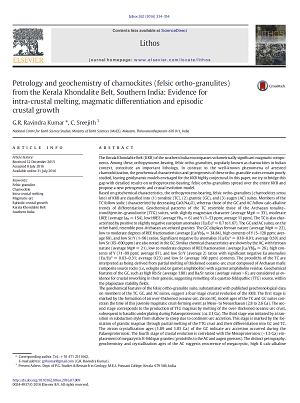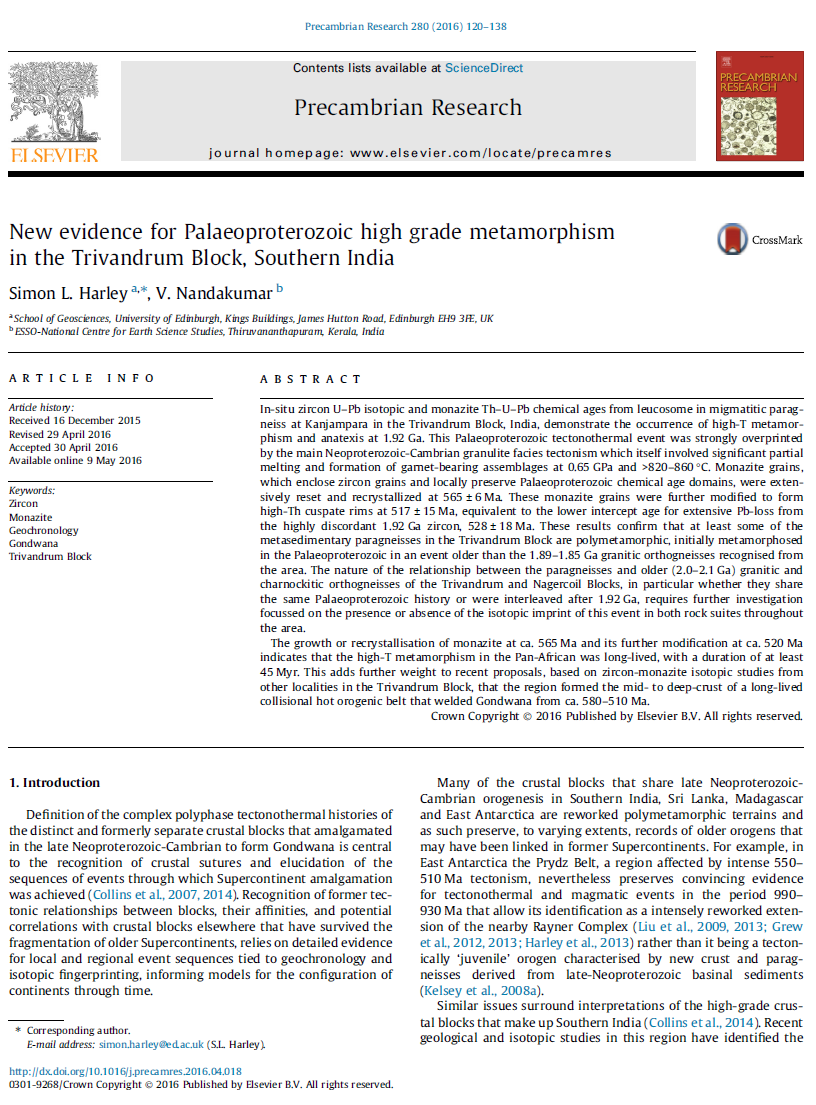Research Updates
 Submarine groundwater discharge (SGD) is an important process driven by marine and terrestrial forces. Low tide affects SGD the most, therefore the ideal time to detect SGD is the low tide, especially during spring tide. Techniques to detect and quantify SGD along with the understanding of the related aquifer characteristics is discussed in this study. Scientific community across the world is realizing the importance of studying and mapping SGD because in the scenario of climate change, this part of the global hydrological cycle is an important process and is known to have a significant effect on the marine ecosystem due to nutrient and metal inputs around the region of discharge. Therefore, understanding the processes governing SGD becomes very important. In this review, various components and processes related to SGD (e.g., Submarine Groundwater Recharge, Deep Porewater Upwelling, Recirculated Saline Groundwater Discharge), along with detailed discussion on impacts of SGD for marine ecosystem is presented. Also, it highlights the future research direction and emphasis is put on more research to be done keeping in mind the changing climate and its impacts on SGD.
Submarine groundwater discharge (SGD) is an important process driven by marine and terrestrial forces. Low tide affects SGD the most, therefore the ideal time to detect SGD is the low tide, especially during spring tide. Techniques to detect and quantify SGD along with the understanding of the related aquifer characteristics is discussed in this study. Scientific community across the world is realizing the importance of studying and mapping SGD because in the scenario of climate change, this part of the global hydrological cycle is an important process and is known to have a significant effect on the marine ecosystem due to nutrient and metal inputs around the region of discharge. Therefore, understanding the processes governing SGD becomes very important. In this review, various components and processes related to SGD (e.g., Submarine Groundwater Recharge, Deep Porewater Upwelling, Recirculated Saline Groundwater Discharge), along with detailed discussion on impacts of SGD for marine ecosystem is presented. Also, it highlights the future research direction and emphasis is put on more research to be done keeping in mind the changing climate and its impacts on SGD.
Bibliographic Info: Suresh Babu, D. S., Ashwini Khandekar, Chandrashekhar Bhagat, Ashwin Singh, Vikrant Jain, Mithila Verma, Brijesh K. Bansal, Manish Kumar [2020]. Evaluation, effect and utilization of submarine groundwater discharge for coastal population and ecosystem: A special emphasis on Indian coastline. Journal of Environmental Management, Vol. 277, Art. 111362. https://doi.org/10.1016/j.jenvman.2020.111362
 The Ediacaran-Cambrian transition period was one of the most significant intervals in the Earth’s history. Widespread changes in the oceanic and atmospheric conditions characterized this interval, which likely triggered the radiation of metazoans. Much of our knowledge of these changes have come from geochemical studies of marine carbonates deposited during this time. In search of such information and to establish the true geographical extent of these events, we carried out a detailed field and geochemical investigation in the Bilara Group of the Marwar Supergroup, the youngest Proterozoic marine carbonate succession of peninsular India. The variations in the 87Sr/86Sr observed in the limestone formation of the Bilara Group (0.70810 to 0.70916) suggest an early Cambrian (520–539 Ma) depositional age for the Group. We identify two δ13C negative excursions of magnitudes ~6‰ and ~7‰, respectively, in the middle and lower parts of the Bilara Group. Since these δ13C anomalies are observed through-out the Marwar Basin that was connected to global oceans, we believe that they represent temporal changes in the chemistry of seawater. Using the principles of δ13C stratigraphy and the available geochronological information, we correlate the middle Bilara anomaly to the Shiyantou carbon isotope excursion (SHICE). Although, poor age constraints hinder a definitive correlation of the older Bilara anomaly, we speculate that it is the basal Cambrian carbon isotope excursion (BACE). These results place the Ediacaran-Cambrian boundary closer to the basal part of the Bilara Group in the Marwar Supergroup.
The Ediacaran-Cambrian transition period was one of the most significant intervals in the Earth’s history. Widespread changes in the oceanic and atmospheric conditions characterized this interval, which likely triggered the radiation of metazoans. Much of our knowledge of these changes have come from geochemical studies of marine carbonates deposited during this time. In search of such information and to establish the true geographical extent of these events, we carried out a detailed field and geochemical investigation in the Bilara Group of the Marwar Supergroup, the youngest Proterozoic marine carbonate succession of peninsular India. The variations in the 87Sr/86Sr observed in the limestone formation of the Bilara Group (0.70810 to 0.70916) suggest an early Cambrian (520–539 Ma) depositional age for the Group. We identify two δ13C negative excursions of magnitudes ~6‰ and ~7‰, respectively, in the middle and lower parts of the Bilara Group. Since these δ13C anomalies are observed through-out the Marwar Basin that was connected to global oceans, we believe that they represent temporal changes in the chemistry of seawater. Using the principles of δ13C stratigraphy and the available geochronological information, we correlate the middle Bilara anomaly to the Shiyantou carbon isotope excursion (SHICE). Although, poor age constraints hinder a definitive correlation of the older Bilara anomaly, we speculate that it is the basal Cambrian carbon isotope excursion (BACE). These results place the Ediacaran-Cambrian boundary closer to the basal part of the Bilara Group in the Marwar Supergroup.
Bibliographic Info: Bivin G. George, Sanjeev Kumar, Jyotiranjan S. Ray [2021]. C-Sr isotope stratigraphy of carbonate formations of the late Neoproterozoic - Cambrian Marwar supergroup, western India. Precambrian Research, Vol. 364, Art. 106378. https://doi.org/10.1016/j.precamres.2021.106378
 The challenge with Raman spectral studies on natural hydrocarbon-bearing fluid inclusions (HCFIs) is the common presence of fluorescence emission from minerals and aromatic compounds in HCFIs leading to the masking of Raman signals. Selection of optimum excitation wavelength is another challenge. To overcome these hurdles, special wafer preparation techniques, along with the use of fluorescence quenchers, were employed in our study to obtain Raman signals from natural HCFIs. The present study is a demonstration of how best the Raman signals from natural hydrocarbon-bearing fluid inclusions could be detected using an excitation wavelength of 785 nm with suitable optical parameters and with special wafer preparation techniques to negate the background fluorescence. Using the laser Raman technique we were able to detect peaks corresponding to cyclohexane, benzene and bromobenzene, carbon monoxide, nitrogen, ethylene, sulphur oxide, carbonyl sulphide, hydrogen sulphide in liquid form along with the presence of a broad peak of liquid water, peaks of calcium carbonate and calcium sulphate. The chemical constituents in natural HCFIs from the same basin identified using laser Raman spectrometric methods with a 785 nm laser excitation agrees well with the GC-MS results of oil in the same basin, which again supports the utility of the laser Raman technique with 785 nm laser for the chemical constituents identification in natural HCFIs. The present study elucidates the potential of Raman spectroscopic methods using a 785 nm laser excitation for detecting the chemical constituents of HCFIs..
The challenge with Raman spectral studies on natural hydrocarbon-bearing fluid inclusions (HCFIs) is the common presence of fluorescence emission from minerals and aromatic compounds in HCFIs leading to the masking of Raman signals. Selection of optimum excitation wavelength is another challenge. To overcome these hurdles, special wafer preparation techniques, along with the use of fluorescence quenchers, were employed in our study to obtain Raman signals from natural HCFIs. The present study is a demonstration of how best the Raman signals from natural hydrocarbon-bearing fluid inclusions could be detected using an excitation wavelength of 785 nm with suitable optical parameters and with special wafer preparation techniques to negate the background fluorescence. Using the laser Raman technique we were able to detect peaks corresponding to cyclohexane, benzene and bromobenzene, carbon monoxide, nitrogen, ethylene, sulphur oxide, carbonyl sulphide, hydrogen sulphide in liquid form along with the presence of a broad peak of liquid water, peaks of calcium carbonate and calcium sulphate. The chemical constituents in natural HCFIs from the same basin identified using laser Raman spectrometric methods with a 785 nm laser excitation agrees well with the GC-MS results of oil in the same basin, which again supports the utility of the laser Raman technique with 785 nm laser for the chemical constituents identification in natural HCFIs. The present study elucidates the potential of Raman spectroscopic methods using a 785 nm laser excitation for detecting the chemical constituents of HCFIs..
Bibliographic Info: JL Jayanthi, V. Nandakumar and S. S. Anoop [2017]. Feasibility of a 785 nm diode laser in Raman spectroscopy for characterizing hydrocarbon-bearing fluid inclusions in Mumbai Offshore Basin, India. Petroleum Geoscience, 23 (3), 2017, 369-375. doi: https://doi.org/10.1144/petgeo2016-071
 The charnockite suites of rocks possess greater significance in addressing the processes operating at lower continental crust and, thereby, provide ample evidence to decipher the petro-tectonic evolution of the Earth’s crust. The new research findings of Ravindra Kumar and Sreejith, published in ‘Lithos’ provide a comprehensive understanding on the lower crustal processes leading to protolith diversification on the genesis of different charnockite suites of southern India. The study distinguishes three different suites of charnockites, viz., tonalitic, granitic, and augen suites based on their petrological and geochemical attributes. Further, the study envisages four-stage magmatic crustal evolution model for the Kerala Khondalite Belt (KKB), spanning from Meso- to Neoarchaean up to Mesoproterozoic. The authors propose that the onset of juvenile magmatism in the KKB was initiated by the formation of Meso- to Neoarchaean basaltic crust in an oceanic lithosphere, which underwent melting due to basaltic underplating leading to the formation of TTGs. Subsequent intra-crustal melting during a stage of arc accretion initiated differentiation of the TTG crust into tonalitic and granitic magmas during Palaeoproterozoic. The fourth stage of crustal evolution is correlated with the Mesoproterozoic emplacement of megacrystic K-feldspar granites. This novel research contribution offers an insight into the long ignored aspect of origin and evolution of orthopyroxene-bearing, felsic ortho-granulites (charnockite) of KKB and their geodynamic setting. The study also establishes fairly–well correlation between the magmatic episodes of KKB and prominent crustal growth events recorded globally. The full-article can be read online at “Lithos” journal website hosted by SciVerse ScienceDirect.
The charnockite suites of rocks possess greater significance in addressing the processes operating at lower continental crust and, thereby, provide ample evidence to decipher the petro-tectonic evolution of the Earth’s crust. The new research findings of Ravindra Kumar and Sreejith, published in ‘Lithos’ provide a comprehensive understanding on the lower crustal processes leading to protolith diversification on the genesis of different charnockite suites of southern India. The study distinguishes three different suites of charnockites, viz., tonalitic, granitic, and augen suites based on their petrological and geochemical attributes. Further, the study envisages four-stage magmatic crustal evolution model for the Kerala Khondalite Belt (KKB), spanning from Meso- to Neoarchaean up to Mesoproterozoic. The authors propose that the onset of juvenile magmatism in the KKB was initiated by the formation of Meso- to Neoarchaean basaltic crust in an oceanic lithosphere, which underwent melting due to basaltic underplating leading to the formation of TTGs. Subsequent intra-crustal melting during a stage of arc accretion initiated differentiation of the TTG crust into tonalitic and granitic magmas during Palaeoproterozoic. The fourth stage of crustal evolution is correlated with the Mesoproterozoic emplacement of megacrystic K-feldspar granites. This novel research contribution offers an insight into the long ignored aspect of origin and evolution of orthopyroxene-bearing, felsic ortho-granulites (charnockite) of KKB and their geodynamic setting. The study also establishes fairly–well correlation between the magmatic episodes of KKB and prominent crustal growth events recorded globally. The full-article can be read online at “Lithos” journal website hosted by SciVerse ScienceDirect.
Bibliographic Info: Ravindra Kumar, G.R. and Sreejith, C., 2016. Petrology and geochemistry of charnockites (felsic ortho-granulites) from the Kerala Khondalite Belt, Southern India: Evidence for intra-crustal melting, magmatic differentiation and episodic crustal growth. Lithos, vol. 262, pp. 334-354. doi: 10.1016/j.lithos.2016.07.009
 In-situ zircon U-Pb isotopic ages obtained on a garnet + cordierite bearing leucosome in migmatitic paragneiss at Kanjampara in the Trivandrum Block, demonstrate zircon crystallisation from melt at 1.92 ± 0.04 Ga. The unique trace element chemistry of the zircon, including high U/Yb, low Th/U, and flat MREE-HREE patterns with pronounced negative Eu anomalies, coupled with the presence of inclusions of sillimanite, apatite, quartz, feldspar and rare biotite in the zircon, confirms its formation as a result of anatexis associated with a high-T metamorphism at 1.92 Ga. This conclusion is supported by the local preservation of Palaeoproterozoic chemical age domains (820-860ºC. The strongly REE-P zoned garnet present in the Kanjampara leucosome, which is demonstrated to not be in HREE or Eu equilibrium with the 1.92 Ga zircon, formed as a result of anatexis and melt interaction during this Neoproterozoic-Cambrian tectonothermal event. Th-U-Pb chemical age data indicates that monazite was either formed or extensively recrystallized at during this anatexis at 565 ± 6 Ma, undergoing further modification to form high-Th cuspate rims at 517 ± 15 Ma. The age of the final monazite chemical modification is equivalent to the lower intercept age of 528 ± 18 Ma for extensive Pb-loss from the highly discordant but otherwise well-preserved Palaeoproterozoic (1.92 Ga) zircon. The growth or recrystallisation of monazite at ca. 565 Ma and its further modification at ca. 520 Ma indicates that the high-T metamorphism in the Pan-African was long-lived, with a duration of at least 45 Myr. The new age-event results from Kanjampara confirm that at least some of the metasedimentary paragneisses in the Trivandrum Block are polymetamorphic, initially metamorphosed in the Palaeoproterozoic in an event older than the 1.89-1.85 Ga granitic orthogneisses recognised from the region.
In-situ zircon U-Pb isotopic ages obtained on a garnet + cordierite bearing leucosome in migmatitic paragneiss at Kanjampara in the Trivandrum Block, demonstrate zircon crystallisation from melt at 1.92 ± 0.04 Ga. The unique trace element chemistry of the zircon, including high U/Yb, low Th/U, and flat MREE-HREE patterns with pronounced negative Eu anomalies, coupled with the presence of inclusions of sillimanite, apatite, quartz, feldspar and rare biotite in the zircon, confirms its formation as a result of anatexis associated with a high-T metamorphism at 1.92 Ga. This conclusion is supported by the local preservation of Palaeoproterozoic chemical age domains (820-860ºC. The strongly REE-P zoned garnet present in the Kanjampara leucosome, which is demonstrated to not be in HREE or Eu equilibrium with the 1.92 Ga zircon, formed as a result of anatexis and melt interaction during this Neoproterozoic-Cambrian tectonothermal event. Th-U-Pb chemical age data indicates that monazite was either formed or extensively recrystallized at during this anatexis at 565 ± 6 Ma, undergoing further modification to form high-Th cuspate rims at 517 ± 15 Ma. The age of the final monazite chemical modification is equivalent to the lower intercept age of 528 ± 18 Ma for extensive Pb-loss from the highly discordant but otherwise well-preserved Palaeoproterozoic (1.92 Ga) zircon. The growth or recrystallisation of monazite at ca. 565 Ma and its further modification at ca. 520 Ma indicates that the high-T metamorphism in the Pan-African was long-lived, with a duration of at least 45 Myr. The new age-event results from Kanjampara confirm that at least some of the metasedimentary paragneisses in the Trivandrum Block are polymetamorphic, initially metamorphosed in the Palaeoproterozoic in an event older than the 1.89-1.85 Ga granitic orthogneisses recognised from the region.




 सूचना का अधिकार
सूचना का अधिकार
